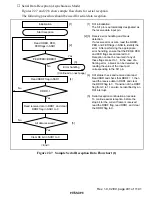
Rev. 1.0, 02/00, page 434 of 1141
Figure 22.9 shows an example of the operation for reception in asynchronous mode.
RDRF
FER
0
1 frame
D0
D1
D7
0/1
1
0
D0
D1
D7
0/1
0
1
1
Data
Start
bit
Parity
bit
Stop
bit
Start
bit
Data
Parity
bit
Stop
bit
ERI interrupt request
generated by framing
error
Idle state
(mark state)
RDR1 data read
and RDRF flag
cleared to 0 in
RXI interrupt
handling routine
RXI interrupt
request
generation
Figure 22.9 Example of SCI Operation in Reception
(Example with 8-Bit Data, Parity, One Stop Bit)
22.3.3
Multiprocessor Communication Function
The multiprocessor communication function performs serial communication using a
multiprocessor format, in which a multiprocessor bit is added to the transfer data, in asynchronous
mode. Use of this function enables data transfer to be performed among a number of processors
sharing transmission lines.
When multiprocessor communication is carried out, each receiving station is addressed by a
unique ID code.
The serial communication cycle consists of two component cycles: an ID transmission cycle
which specifies the receiving station, and a data transmission cycle. The multiprocessor bit is used
to differentiate between the ID transmission cycle and the data transmission cycle.
The transmitting station first sends the ID of the receiving station with which it wants to perform
serial communication as data with a 1 multiprocessor bit added. It then sends transmit data as data
with a 0 multiprocessor bit added.
The receiving station skips the data until data with a 1 multiprocessor bit is sent.
When data with a 1 multiprocessor bit is received, the receiving station compares that data with its
own ID. The station whose ID matches then receives the data sent next. Stations whose ID does
not match continue to skip the data until data with a 1 multiprocessor bit is again received. In this
way, data communication is carried out among a number of processors.
Figure 22.10 shows an example of inter-processor communication using a multiprocessor format.
















































